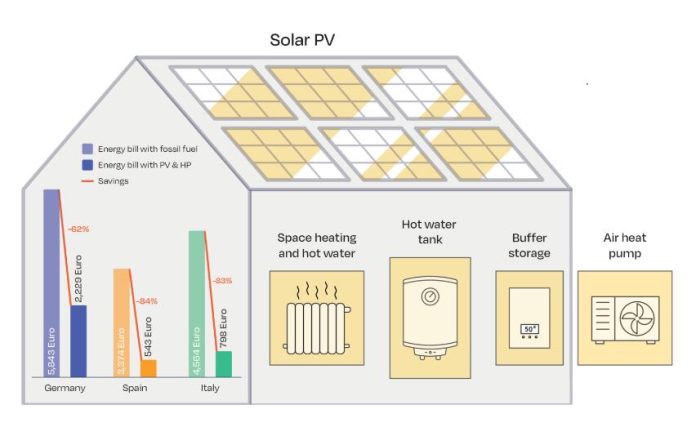It pays off to install heat pumps with PV in residential homes in Germany, Spain, and Italy, rather than either technology on its own, SolarPower Europe says in a new report.
“A solar PV installation complements a household’s heat pumps and fulfills a significant extent of its electricity needs. The savings for the two technologies together are then higher than for each individual technology,” the report says.
The industry body modeled three scenarios for medium-sized households in Germany, Spain, and Italy during the energy crisis in 2022. A “PV-only” scenario, a “heat pump-only” scenario, and a “PV plus heat pump” combo scenario, which also includes a buffer – a warm water storage tank. The savings are compared to the price that the average family household would pay by sourcing all its electricity from the grid and using a gas boiler for heating.
The PV system was assumed to have capacities of 8 kW in Germany and 7 kW in Spain and Italy. An air-source heat pump with 7 kW, 3 kW, and 4 kW output was modeled for the three countries, respectively. In Germany, the capacity of the storage tank was set to 800 liters, and to 400 liters in both Spain and Italy.
The thermal demand for space and water heating was modeled at 12,000 kWh to 20,000 kWh, for existing building stocks and using a gas boiler with 85% efficiency. The annual electricity demand for an average family home was assumed at 4,000 KWh to 4,500 kWh, and the gas and electricity prices for 2022 were set according to the Household Energy Price Index.
“All relevant support measures applying to average family homes are included,” SolarPower Europe said, noting that this includes VAT cuts on gas in all three countries. For PV electricity generation, savings from feeding electricity back to the grid are also included.
The results show that Italian households saved the most by using a PV-heat pump combo at €3,766 ($3,984), reportedly due to high electricity prices in Italy. Germany followed with savings of €3,614, and Spain at €2,831.
“Reduced savings in Spain reflect the measures taken by the Iberian market to lower wholesale electricity prices,” said SolarPower Europe.
The combination of both technologies reduced the energy bill by 62% in Germany, 83% in Italy, and 84% in Spain, in comparison with the scenario where households sourced all electricity from the grid and used gas for heating.
In the “heat pump-only” scenario, savings for Germany stood at €1,884, €958 for Spain, and €506 for Italy. In the “PV-only scenario”, Italy had savings of €2,935, Spain of €1,352, and Germany of €1,263.
The study also shows that solar PV and heat pumps work effectively together throughout the year if the buffer storage tank is also installed. In Germany, solar power can cover 36% of total heat pump electricity demand in a cold year with low PV output, according to SPE. Spain and Italy, showered with sun, present the best results. Even in a cold year with low PV input, solar covers 59% of the heat pump demand in Spain, and 50% in Italy.
SPE concludes the report with five policy recommendations for lowering the payback period of the PV-heat pump combo from purportedly around 20 years at present to a much more attractive 10 years. These include increasing Capex support for combined investments, offering loans at a low-interest rate, and promoting collective self-consumption.
“The best time to install solar PV + heat pumps was yesterday,” said Dries Acke, policy director of SolarPower Europe. “The next best time is now. European policymakers need to bring the benefits of gas-free homes to the wider population.”






